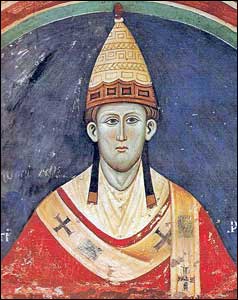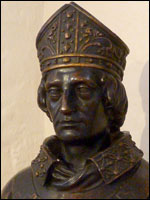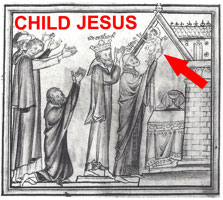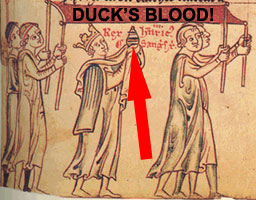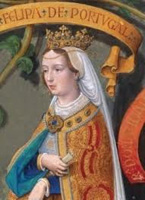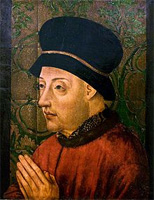AFTER 244 YEARS AND 7 KINGS, THE NOBLE ROMANS DISCOVERED THAT THE ROMULUS
DYNASTY WAS A DISASTER . . . SO IN 509 BC THEY BANNED KINGS FOREVER!! |
It took that roaring lion Satan over 1000 years before he could launch his vicious counterattack against the Gospel of Christ:
And when the thousand years shall be finished, Satan shall be loosed out of his prison, and shall go forth, and seduce (Gk. planeō: deceive) the nations, which are over the four quarters (Gk. gonia: corners) of the earth, Gog and Magog, and shall gather them together to battle, the numbers of whom is as the sand of the sea (Apocalypse 20:7, Douay-Rheims Version).
About 90 AD, when Saint John wrote the Apocalypse in the Greek language, the earth still had 4 CORNERS.
The GLOBE comes from the English language translation of the corrupt Latin Vulgate Version:
It is he that sitteth upon the GLOBE of the earth, and the inhabitants thereof are as locusts: he that stretcheth out the heavens as nothing, and spreadeth them out as a tent to dwell in (Isaiah 40:22, Douay-Rheims Version).
Remarkably, that deadly dynasty ruled England for about the same length of time and had 8 kings....It was the Fifth Monarchy Men in 1649 who first tried to rid their imprisoned island of kings and queens.
Henry II was the first king in the demonic dynasty!
Henry Plantagenet was the first king in the Devil's dynasty. It was really his wife Eleanor of Aquitaine who ruled from behind the scenes.
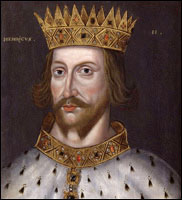 King Henry II (1133–1189). Misruled from 1154 to 1189. |
|
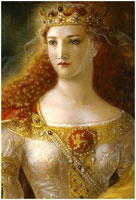 Queen Eleanor (1122–1204). Queen from 1154 to 1189. |
Most people remember King Henry for the assassination of Thomas Becket. That false flag operation led to the conquest of Ireland in 1171.
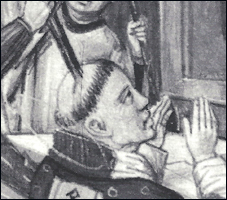 Artistic depiction of the sword slashing Becket's head. |
|
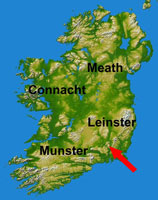 The route of Henry's invasion of Ireland in October 1171. |
King Henry passed away suddenly in 1189 and he was succeeded by Eleanor's favorite son Richard.
King Richard I was the second king in the demonic dynasty!
Cowardly Lion King Richard I was the second king in the demon's brood.
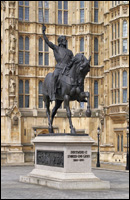 Statue of King Richard I outside Parliament in London. |
|
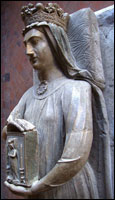 Queen Beregaria (1165–1230). Queen from 1191 to 1199. |
While conquering the island of Cyprus, Eleanor the Amazon caught up with her son and forced him to marry Berengaria of Navarre. She knew that a future King of Jerusalem needed a wife to make his claim to the throne of the "Holy City" legitimate.
Richard died without male children and he was succeeded by his younger brother John.
King John was the third king in the demonic dynasty!
King John is mostly known for his signing the Magna Carta which gave "freedom" to the barons and the common people. Nothing could be further from the TRUTH.
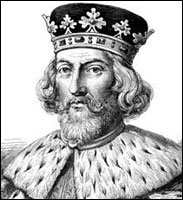 King John (1166–1216). Reigned from 1199 to 1216. |
|
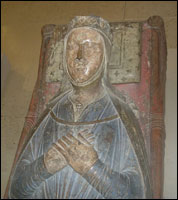 Queen Isabella (1186–1246). Queen from 1200 to 1216. |
The burning issue of his reign was the right to appoint the archbishop of Canterbury—the second most powerful political and religious figure after the king.
|
|
That total control was codified in the Magna Carta (Great Charter) which Henry signed with his barons in June 1215. It was the GREAT CHARTER of freedom for the Church of Roma in England. Here is a brief quote from the preamble:
1. In the first place have granted to God and by this our present charter have confirmed, for us and our heirs in perpetuity, that the English church shall be free, and shall have its rights undiminished and its liberties unimpaired: and we wish it thus observed, which is evident from the fact that of our own free will before the quarrel between us and our barons began, we conceded and confirmed by our charter freedom of elections, which is thought to be of the greatest necessity and importance to the English church, and obtained confirmation of this from the lord and pope Innocent III, which we observe and wish our heirs to observe in perpetuity (Morris, King John: Treachery and Betrayal in England, p. 300.)
Lawyers today refer to the Magna Carta as the first real democratic document and the foundation of personal freedom. Nothing could be further from the truth. It bound the church in England to the Papacy with iron chains.
One benefit of the Interdict was the fact that no English children joined the Children's Crusade. From that time onward, the archbishops of Canterbury were always appointed by the Pope in Roma.
King Henry III was the fourth king in the demonic dynasty!
The next king we encounter as we survey the Plantagenet demonic dynasty was the son of King John and Isabella of d''Angoulême.
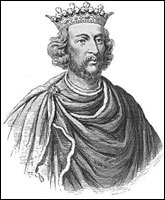 King Henry III (1207–1272). Misruled from 1216 to 1272. |
|
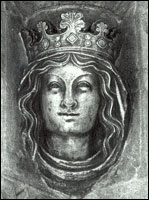 Queen Eleanor of Provence (1223–1291). |
Henry was a real superstitious Catholic and his hero was Edward the Confessor—the first English king to be called by the name Edward.
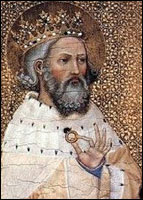 Edward the Confessor (1003–1066). Misruled from 1042 to 1066. |
|
Because of his frequent visions of the Real Presence or the Child Jesus in the host, he gave credibility to the new doctrine of transubstantiation. King Henry wanted a shrine in London that would showcase Edward and rival Canterbury as a magnet for pilgrims from around the country.
In 1245, he demolished the old St. Peter's Church and built Westminster Abbey on the site.
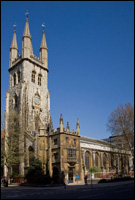 The Church of Saint Sepulchre in London. |
|
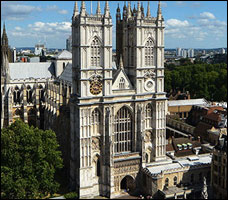 The king rebuilt Westminster Abbey to house the "duck's blood" reliquary. |
The previous church, named St. Peter's, was built before the Norman Conquest and housed the bones of Edward the Confessor. Henry knocked that church down and rebuilt it on a massive scale. He gave a prominent place to the bones of his hero Edward the Confessor. By that time, Edward was canonized by Pope Alexander III— the same Pope that canonized Thomas Becket.
In June 1247, he claimed that Robert, Patriarch of Jerusalem, sent him a reliquary with "Christ's blood" from the Holy Sepulchre in Jerusalem.
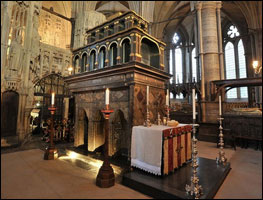 Tomb of Edward the Confessor in Westminster Abbey. |
|
Here is a report by a monk and eyewitness to that event named Matthew Paris:
According to Matthew Paris, on the day appointed, the King announced that he had come into possession of a most precious relic; a portion of the blood of Jesus Christ, sent to him under the seals of the patriarch of Jerusalem, the masters of the Templars and the Hospitallers and various bishops from the Holy Land. From the time of its arrival in England, the relic is said to have been kept a closely guarded secret, stored at the London church of the Holy Sepulchre. Having spent the previous night in fasting and prayer, early in the morning of 13 October, Henry led a procession from St. Paul's Cathedral to Westminster. Dressed in a simple cloak, he carried the crystal vase containing Christ's blood in his own hands, supported by two attendants and walking beneath a pall borne by four spears. For the two miles of his journey he is said to have kept his gaze fixed upon heaven and the relic he kept in his hands. (Vincent, The Holy Blood: King Henry III and the Westminster Blood Relic, p. 3).
In medieval England, the duck's blood reliquary was the mother of all pious frauds....The sophisticated Londoners never bought the "duck's blood" relic and Westminster Abbey never eclipsed Canterbury as a site of "miracles." Additionally, CORPUS CHRISTI, or the new doctrine of transubstantiation created by Pope Innocent III, was competition for the duck's blood.
Here is what the Jewish Messiah Joshua said about dead men's bones:
Woe to you scribes and Pharisees, hypocrites; because you are like to whited sepulchres, which outwardly appear to men beautiful, but within are full of dead men's bones and of all filthiness (Matthew 23:27, Douay-Rheims Version).
No record exists of how many "miracles" were performed by the "duck's blood" reliquary before it was destroyed by order of good King Henry in 1538. Unfortunately, the dead men's bones still remain in the Abbey.
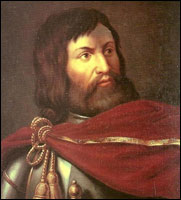 Simon de Monfort (1208–1265). 6th earl of Leicester. |
|
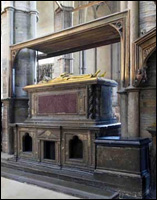 Tomb of King Henry in Westminster Abbey. |
During the Albigensian Crusade, Simon's father was asked how they could differentiate between Catholics and heretics, to which he replied: "kill them all, God will know his own."
King Henry lived only a few years after the Battle of Eversham, in which Monfort was slain, and his body mutilated by the soldiers. The disasters that the king brought on his country are well documented but little is known about his fanatical devotion to the Church of Roma.
King Edward I was the fifth king in the Devil's dynasty!
King Edward I needs no introduction. He is known as a brutal Crusader and ruthless soldier who waged incessant wars against Wales and Scotland.
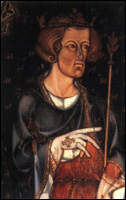 King Edward II (1239–1307). Misruled from 1272 to 1307. |
|
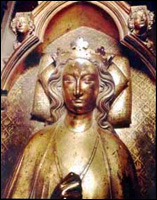 Eleanor of Castile (1241–1290). Queen from 1279 to 1290. |
King Edward was determined to subjugate Scotland and annex the freedom-loving people to the growing British Empire. In September 1297, his Crusaders were defeated by a Scottish nobleman named Sir William Wallace.
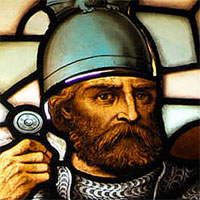 Sir William Wallace (1270–1305). |
|
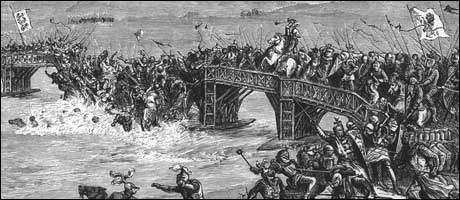 The Battle of Sterling Bridge took place in September 1297. |
The defeat only embittered Edward, and in 1298 he reentered Scotland with over 25,000 Crusaders under his command. The British Secret Service—founded by Queen Eleanor of Aquitaine—had spies everywhere.
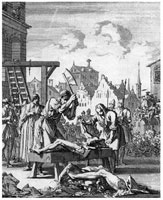 Artistic depiction of the brutal execution of Sir William Wallace. |
|
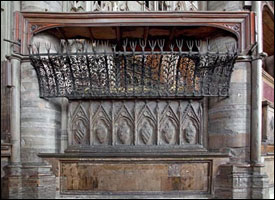 Tomb of King Edward and Eleanor in Westminster Abbey. |
Sir William's body was chopped up and his head was displayed on Tower Hill as a warning to anyone else who would challenge the tyrannical rule of King Edward I.
The king's tomb contains the inscription Malleus Scotorum meaning "Hammer of the Scots." He was also the hammer of the Welsh because his son became the first Prince of Wales. .
King Edward II was the sixth king in the Devil's dynasty!
The next king we encounter in the Plantagenet house of horrors was Edward II. The dead king's son Edward was in fact the first Prince of Wales. He was given that title by his father after that country was annexed to the British Empire.
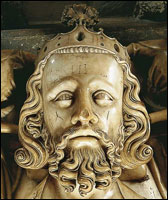 King Edward II (1284–1327). Misruled from 1307 to 1327. |
|
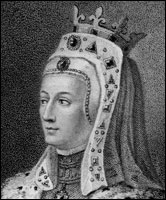 Isabella of France (1295–1358). Queen from 1326 to 1330. |
The couple never met until Edward became king and had to marry Isabella to cement his alliance with the king of France.
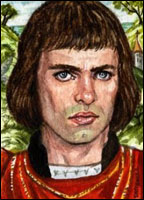 Lover boy Piers Gaveston (1284–1312). |
|
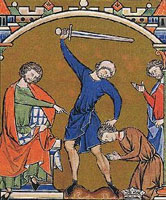 The beheading of Piers Gaveston in 1312. |
The barons forced the king to exile Gaveston but he returned after a short stay in Flanders. Finally, he was arrested in Wales and beheaded by Thomas, Duke of Lancaster.
 King Edward's red hot rectum poker. |
|
 POKER FACE: King Edward died by a red hot poker up his rectum. |
King Edward was murdered on September 21, 1327, in the most revolting manner:
But there was no escaping his tormentors, who spread his legs and inserted a 'long horn into his fundament as deep as they might, and took of spit of burning copper, and put it through the horn into his body, and oftentimes therewith his bowels, and so they killed their lord, and nothing was perceived.' This is the earliest account of Edward being murdered in this revolting and sadistic manner, and it may be one of the stories to which the canon of Bridlington was referring (Weir, Queen Isabella: The She-Wolf of France, p. 286).
Most of the people believed that the manner of his death was poetic justice for his debauched lifestyle. He was not buried in Westminster Abbey.
In 1309, a political and religious earthquake shook the entire world when the Papacy was forced to abandon Roma and move to Avignon, France.
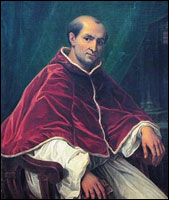 Avignon Pope Clement V (1264–1314). Misruled from 1305 to 1314. |
|
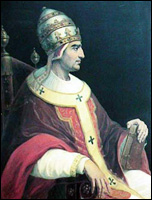 Avignon Pope Gregory XI (1264–1314). Misruled from 1305 to 1314. |
A greatly humbled Papacy returned to Roma in 1376, but her power and prestige were greatly shaken by the so-called Seventy Years' Babylonian Captivity.
King Edward III was the seventh king in the Devil's dynasty!
The next king in the demonic Plantagenet dynasty was Edward III—the son of King Edward I.
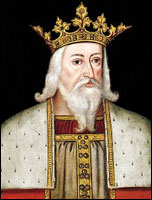 King Edward III (1312–1377). Misruled from 1327 to 1377. |
|
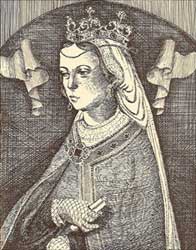 Queen Philippa 1314–1369. Queen from 1328 to 1377. |
Norman laws of inheritance were in force on that imprisoned island so the firstborn son of the Prince of Wales was second in line to the throne.
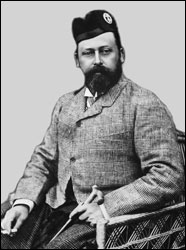 Edward Prince of Wales (1330–1376). |
|
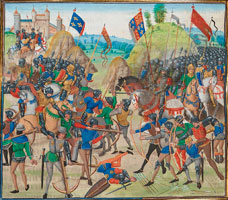 The Battle of Crécy in August 1346. |
The Prince of Wales was called John of Ghent because he was born in Ghent, Flanders. He died just one year before his father, becoming the first Prince of Wales not to become king of England.
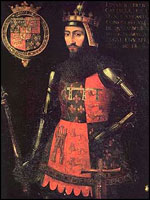
John of Ghent
(1340–1399). |
|
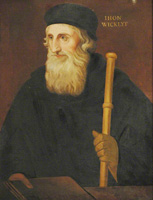 Saint John Wycliffe (1320–1384). |
Primogeniture, and his friendship with Reformer John Wycliffe, cost him the throne:
Inevitably, there was resistance in some quarters to the firmness with which Gaunt had reasserted royal authority. The fieriest opposition to the duke's policies was to be found in the capital. During the January session of parliament Gaunt had done little to endear himself to the citizenry. On 19 February he had pushed his way into St. Paul's to rescue his protégé, the radical clerk John Wyclif, from the clutches of the bishop of London and his clerical accusers. (Saul, Richard II, p. 21).
The duke had an unimpeachable claim to the throne. Had he become king, he would have been a 13th century King Henry VIII, and Saint John Wycliffe would have been the English Saint Martin Luther.
|
|
|
That was the reason why the British government never accepted the Bull of Borgia and the spurious Spanish claim to the New World.
King Richard II was the eight king in the Devil's dynasty!
Changing the rules of succession is like changing the rules in a football game to suit the losing side. The law of primogeniture favored the firstborn and second or third sons were barred from the succession. That demonic law was the reason why Charles married Diana to produce an "heir and a spare," even though Charles has 2 living brothers.
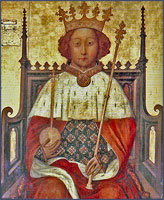 Boy King Richard I (1367-1400). Misruled from 1377 to 1399. |
|
 Anne of Bohemia was the wife of King Richard II. |
The anti-Scriptural feudal law of primogeniture was written by canon lawyers to keep wealth concentrated in a few families. When Samuel the Prophet went to anoint David as Israel's first king, he completely ignored primogeniture:
Thus Jesse made seven of his sons pass before Samuel. And Samuel said to Jesse, “JEHOVAH has not chosen these.” And Samuel said to Jesse, “Are all thy sons here?” Then he said, “There remains yet the youngest, and he is keeping the sheep.” “Send and bring him, for we will not sit down until he comes here” (I Samuel 16:10-11).
The twin Esau was born before Jacob, but firstborn Esau was rejected as a profane and faithless man. Solomon, one the greatest kings that ever lived, was not David's firstborn.
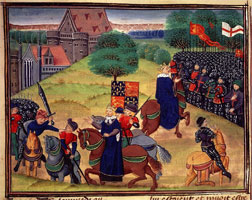 The Peasants' Revolt of 1381. |
|
 King Richard—a mere boy of 14— addressing the peasants. |
The people weren't marching to get rid of the boy king and put a man on the throne. They were only interested in tax relief. In what seems like a false flag operation, they entered London, hoping to kill John of Ghent, but he was away at that time:
Further along the Strand they forced their way into Gaunt's palace of the Savoy and razed it to the ground. The Lancastrian chronicler Knighton said that they drank the wine in the cellers and cast the duke's plate into the river (Saul, Richard II, p. 64).
Richard was forced to abdicate in 1399, and the following year he was dead.
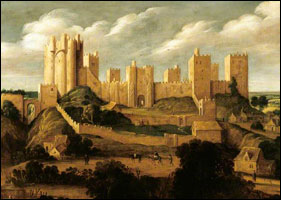 Pontrefact Castle where Richard was imprisoned and died. |
|
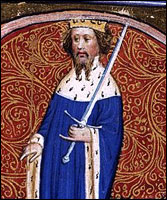 King Henry IV (1367–1413). King from 1399 to 1413. |
From that time onward, rival branches of the Plantagenet dynasty, known as the Houses of Lancaster and York, competed for the throne. As well as the ongoing war with France, the country now experienced the War of the Roses between those competing dynasties.
In August 1485, a decisive battle was fought between the Houses of Lancaster and York. Henry Tudor, Earl of Richmond, was the winner, and thus began the great Tudor dynasty whose brightest star was King Henry VIII.
